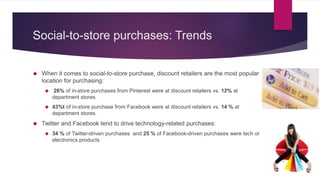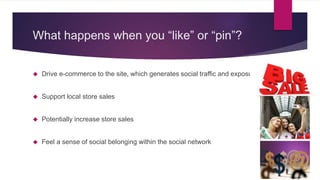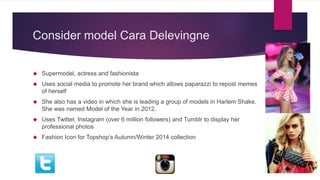Fashion in social media 2
- 1. Fashion in Social Media JESSICA CARRIGAN, JULIO CAMPOS, REBECCA FOX & KIRAN RAM
- 2. OVERVIEW
- 3. Effects of Fashion on the Individual Helps determine self identity Self expression Helps relay a mood Canvass for displaying interests, opinions, logos brand names Send a message
- 4. Creating Identity Consider the popular TLC show What Not to Wear This show is geared towards giving the average women a fashion makeover in order to match her fashion with her personality Helps find and define her identity Fashion helps to obtain optimal identity performance in the workplace and in society Offers fashion tips to help dress different body shapes while wearing clothes that best define you as a person Identity can be expressed through fashion!
- 5. Technology is everywhere in Fashion Employment research Trend Research Reports Videos, Podcasts, Blog postings Trend, concept and mood boards Client presentations
- 6. Technology is everywhere in Fashion Technical Specification sheets Costing and Markup Sheets Store Layout and Design Product Development and Merchandising Database Applications Virtual Fashion Design and Merchandising
- 7. Social Media used in Fashion: Trends Fashion icons- active users of social media sites such as Facebook, Instagram, Twitter and Tumblr create a platform for exposure of clothing by fashion designers Live social streams during live streams of runway shows- many designers are adding social media streams to live stream shows to allow others to view the opinions of others Fashion Apps- can be downloaded to a computer or mobile device to allow one to follow favourite designers, express favourite styles and help find different styles i.e. Lyst (create your own store) Polyvore (internet-based trendboard), VisualRetailing (visual merchandising and retail execution applications)
- 8. New York Fashion Week Trends One study from eBay Deals looked into data from five social networks during NYFW and found more people are using social media for wardrobe advice, inspiration and the latest trends. Top fashion accounts live tweeted from the shows and two brands, Badgley Mischka and Bergdorf Goodman, co-previewed their collections exclusively on Pinterest. Fashion-related tweets doubled from last year's events Professional photographers made use of Instagram. Fashionistas can keep track of events and viral moments through a live feed that curates tweets and pictures from attendees.
- 9. Social Media On the Rise: Tweeting Revenue There has been an astounding 357 % increase in sales from social traffic compared to last year. 91% of e-commerce retailers saw a lift in their SEO rank thanks to social referrals. Over the period of Jan.- June 2013, social traffic to e-commerce sites has created a revenue increase of 17.8 % 30% of Twitter users begin thinking and tweeting about holiday shopping before October 65% percent of consumers use social media to find the perfect gift for people.
- 10. Did you know? Four in 10 social media users have purchased an item in-store or online after sharing or “liking” on Facebook, Twitter or Pinterest. Social media drives about equal proportions of online and in-store purchases. Half of social media-driven purchasing happens within 1 week of sharing, tweeting, liking or favoriting the product. 74 %of consumers rely on their social networks to make purchase decisions. When it comes to sharing news about their online purchases, 55%of consumers choose Facebook, 22% share on Twitter, 14% on Pinterest and 5% share on Instagram.
- 11. Social Media drives traffic to retail sites Facebook is the leader when it comes to driving social traffic to retail sites (responsible for about 60 %) with Polyvore (20 %) and Pinterest (15 %) Polyvore drives a higher average order value than Facebook, Pinterest and Twitter combined. Polyvore’s average order value is $383, versus Pinterest’s $199.16, Facebook’s $92.27 and Twitters’s $58.02. While Twitter and Facebook tend to drive purchases of products people were already researching or considering, Pinterest is more likely to drive spontaneous purchases.
- 12. Social-to-store purchases: Trends When it comes to social-to-store purchase, discount retailers are the most popular location for purchasing: 26% of in-store purchases from Pinterest were at discount retailers vs. 12% at department stores. 43%t of in-store purchase from Facebook were at discount retailers vs. 14 % at department stores. Twitter and Facebook tend to drive technology-related purchases: 34 % of Twitter-driven purchases and 25 % of Facebook-driven purchases were tech or electronics products
- 13. What happens when you “like” or “pin”? Drive e-commerce to the site, which generates social traffic and exposure Support local store sales Potentially increase store sales Feel a sense of social belonging within the social network
- 14. Retailer issues with Social Media Creating and maintaining loyalty- In order to maintain customer loyalty, retailers and designers must make a conscious effort not to ignore social media communications, and play an active role in engaging their consumers Social Traffic is meaningful without sales revenue- Social traffic creates exposure, which leads to an increase in sales eventually, but may not occur right away If you don’t use it, you lose it- once a retailer or designer participates in social media networks and blogs, they must remain active members in order to increase social capital and revenue (social media sells!)
- 15. Celebrity Involvement Never Hurts Fashion shows, designers and products always gain huge exposure with celebrity endorsement See Taylor Swift Performance at the Victoria Secret Fashion Show Brings lovers of music, fashion and celebrity into one https://www.youtube.com/watch?v=tNoRkxCBi6Q
- 16. Consider model Cara Delevingne Supermodel, actress and fashionista Uses social media to promote her brand which allows paparazzi to repost memes of herself She also has a video in which she is leading a group of models in Harlem Shake. She was named Model of the Year in 2012. Uses Twitter, Instagram (over 6 million followers) and Tumblr to display her professional photos Fashion Icon for Topshop’s Autumn/Winter 2014 collection
- 17. Social Media & the Fashion Industry Mashable.com, 2013
- 18. How Social Media bridges the gap With continuous growth and new innovations it’s easy so say Social Media and Fashion have come a long way in a short period of time What was once only available to a select class such as the rich and famous, fashion- whether it be high end or a new and upcoming street designer, is now accessible to anyone and everyone Fashion shows, previews, collections and even interactive discussions are being made available and even incorporating its consumers all thanks to Social Media!
- 19. Front Row Seats- Online! More and more Fashion labels are using social media for not only exposure, but inviting us to have front row seats! With its high demand, fashion shows from around the world are now accessible to everyone on demand through various social media outlets! Mashable.com, 2013
- 20. Front Row Seats- Online! Most popular social media sites get involved with fashion week and popular fashion shows, for example: Pinterest- A popular photo sharing website that uses pictures, videos and inspiration boards to post live coverage Twitter- Designers, Brands and attendees post tweets of live, up to date footage and information at shows and viewings (Sendible.com, 2014)
- 21. Live Fashion Shows Online Instagram- Uses pictures and videos to promote inspiration and exposure of designers and brands during and long after fashion shows Youtube- Brands and Designers can utilize this social media site to stream live coverage of shows and behind the scene action Check out Burberry’s Fall/Winter 2014 Collection here on Youtube and see for yourself! https://www.youtube.com/watch?v=dL9JVxq6x2M
- 22. Live Fashion Shows and #’s Another way Fashion labels and designers attempt to get their consumers involved and interactive with live shows if through Hashtags (#) The idea behind this concept is to not only engage the audience but at the same time gain exposure For example: #FashionWeek2014
- 23. Brand Awareness Fashion and Social Media go hand-in-hand, that’s why fashion brands and retailers have utilized the booming online social media world of over 1 billion users, to gain exposure, interest and overall name for themselves. More and more new and upcoming labels and designers are fast tracking and obtaining exposure and interest through social media as opposed to the days when it could take years to obtain that kind of recognition. Econsultancy, 2012
- 24. Brand Awareness continued… For example, Burberry a high end fashion label once known to be untouchable and almost illusive to the every day street shopper, accumulated over 80,000 mentions during a 5-day period of Fashion Week ast year alone. Many other brands found themselves dominating virtual conversation during fashion week as well thanks to Social Media which in turn drove sales up This type of exposure online continues to help the fashion industry and to small scale designers thanks to its availability and activity.
- 25. #RunwayTrends to #TrendingTopics Thanks to social media sites such a twitter, Designers and brands are now able to use the site to keep consumers updated about upcoming trends, colours and news about the label. This type of communication helps high fashion to become more accessible, personable and often works to engage customers and has been proven to enhance a higher brand loyalty among customers.
- 26. #RunwayTrends to #TrendingTopics One example of how this trend works in favour of the fashion lable is Victoria Secret Victoria’s Secret launched the hashtag (#) #VSteeneybikini on Pinterest , Instagram and Twitter. VS had approximately 27,000 followers on Pinterest and just over 20,000 of those followers used the #VSteeneybikini and are following the Pinterest board.
- 27. Social Media in the Fashion Industry Here is a great video that explains how the fashion industry uses social media to connect consumer s http://www.bloomberg.com/video/social-media-in-the-fashion-industry- 6A6WWK0cQR~gOjYNP6AmiQ.html Psfk.com, 2014


























